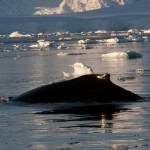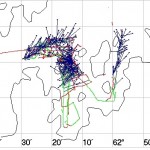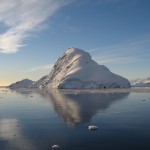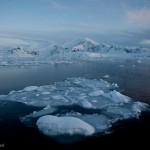When we woke up this morning we didn’t have to contend with yesterday’s low visibility; instead we encountered 20 knot winds and choppy seas, even in the shelter of Wilhelmina Bay.
Despite the weather, our tagged whale was in sight at first daylight and the small boats were deployed. Once the tag came off the whale it was handily retrieved by Pat Halpin, Jeremy Lucke, Andy Read and Joe Warren, and the small, “very wet” boat teams returned to the warmth of the NB Palmer.
- Pat Halpin and Andy Read locate D-Tag
After lunch we headed out of Wilhelmina Bay and into the unprotected Gerlache Strait where we experienced the full force of the wind — 40 knots blowing from the west, straight down the Gerlache. As we transited, several members of the visual survey team conducted a strip transect survey from the bridge, noting occasional humpback whales, fur seals, a ‘flurry” of gentoo penguins, and many seabirds including a new species for this trip, an Antarctic petrel. The remainder of the visual team looked for whale blows from inside the ice tower — too windy to survey from outside!
Since we are departing Wilhelmina Bay tonight, we thought it would be fun to summarize all of the research that we have accomplished here on this trip. The tagging team deployed six D-tags (totaling over 134 hours of humpback whale diving behavior) collected 19 skin samples for genetic analysis and gender identification, and deployed two Crittercams totaling over 20 hours of visual glimpses of whale behavior underwater.
- Humpback with D-Tag
The visual survey team thoroughly surveyed throughout the entire bay, totaling 225 km of survey effort. During the distance transects, we sighted 383 groups of humpback whales, 8 groups of minke whales and 1 sighting of a southern right whale. During the strip transects we sighted numerous seabirds, seals, and whales, thereby documenting the importance of this area to a variety of Antarctic predators.
- Whale sightings in Wilhelmina Bay; the green line is our survey route (the red lines are off-effort transits), the blue vectors are humpback whale sightings and the green vectors are minke whale sightings.
The prey mapping team documented the massive amounts of krill found in this bay. They conducted five MOCNESS tows, capturing zooplankton at different depths in the water column; and 17 CTD casts, providing hydrographic profiles of the bay’s water temperature, salinity and depth. They also sent nearly 300,000 “pings” from the transducers mounted on the NB Palmer and logged over 175 km of survey effort in the small boat mapping the krill prey field.
- Antarctic Krill
With all of these data being collected, the data processing and visualization team have been extremely busy (and efficient) at keeping everything organized and up to date. Many thanks to them for all their hard work and constant acceptance of new data!
Tomorrow we will wake up in Flandre’s Bay which will be exciting, but it will also be bittersweet as we will likely not be returning to Wilhelmina Bay on this trip. Wilhelmina Bay is special to me as it is where we were the first day I woke up and knew I was in the Antarctic.
- Delaite Island
However, we are not the first to think that this is a special bay. Sir Ernest Shackleton and his crew abandoned his ship, the Endurance, after it was crushed in the ice of the Weddell Sea in the austral spring of 1915. His initial plan was to drag his small boats and gear to an island on the eastern side of the Antarctic Peninsula and then take a small party across the Peninsula by foot (!) to Wilhelmina Bay, which he knew was frequented by whalers working from Deception Island.
So, as in many aspects of science, the tremendous abundance of whales and krill we are documenting this year (and last) is something known almost 100 years ago by the intrepid souls who ventured here in wooden boats to hunt whales. Perhaps, through our science (and some advocacy) we can now do our part to help protect this amazing place and ensure that humpback whales will always frequent the waters of Wilhelmina Bay.
-Danielle
P.S. A very happy birthday to Doug’s brother, David.
- Wilhelmina Bay






